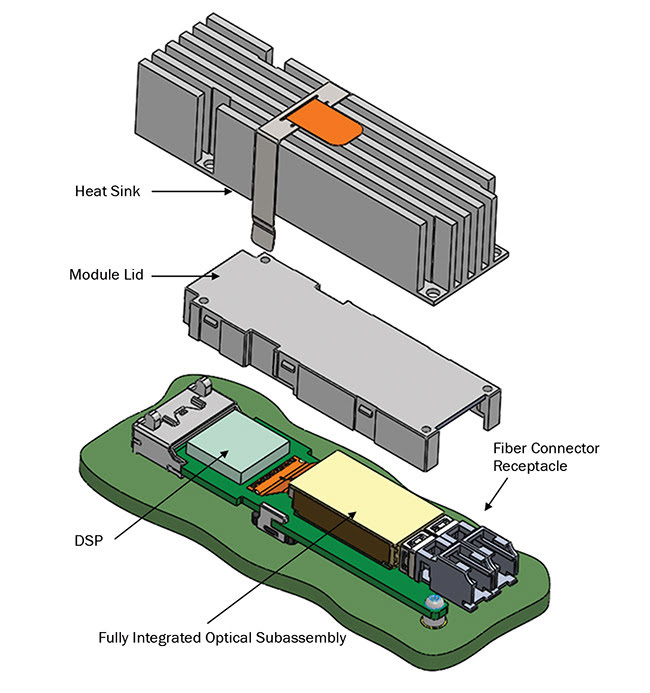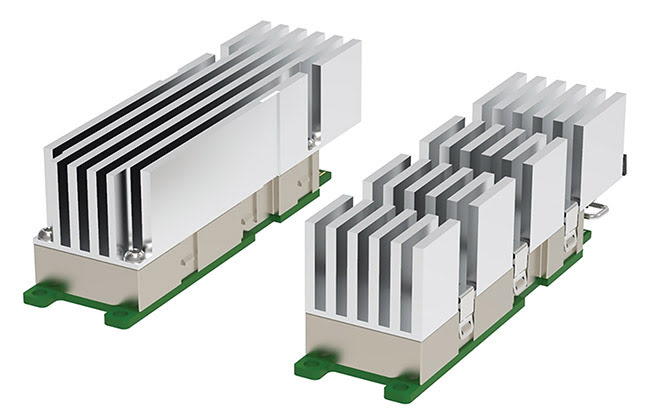ANA BELÉN GONZÁLEZ GUERRERO, EUROPEAN PHOTONICS INDUSTRY CONSORTIUM (EPIC)
In the quickly evolving datacom and telecom fields, one of the best ways to speed up the replacement of old technology is through the development of common rules for the manufacturing of interchangeable and interoperable optical modules.
EPIC, in partnership with the Consortium for On-Board Optics (COBO), is developing specifications to permit the use of board-mounted optical modules in the manufacturing of networking equipment such as switches and servers.
Component control
Standardization has attracted a lot of attention in the datacom and telecom industries as a way to overcome the currently inconsistent design philosophies caused by the fragmented nature of equipment suppliers. The standardization of components provides many advantages, the most obvious being the ability to mass-produce a component. Also, modularity enhances the effectiveness of equipment, and the combination of modular components with standardized structure and connections enables faster, cheaper, and easier manufacturing, installation, and operation.
Established in 2015, COBO is a member-driven, mutual-benefit, nonprofit consortium based in Beaverton, Ore. (U.S.), that is working to develop specifications and standards to permit the use of board-mounted optical modules in the manufacturing of networking equipment for network switches and server adapters. It focuses on electrical interfaces, pinouts, connectors, thermals, and so on, for the development of interchangeable and interoperable optical modules that can be mounted onto motherboards and daughtercards. The organization’s end goals are to reduce the power requirement in switches and server adapters for optical interfaces, and to increase switch faceplate bandwidth density.
COBO comprises about 70 companies in the fields of telecommunications, semiconductors, IT, and software, and has two working groups: Data Center Networking (DCN) — which splits into three subgroups (electrical, mechanical, and use cases and reliability) — and Coherent (CohOBO).
The adoption of COBO’s modular standardization as a design strategy for the physical infrastructure of data centers will help decrease costs, reduce downtime, and increase business opportunities. Standardization and its modularity can create wide-ranging benefits for inter- and intradata center connections in which more capacity is needed because of the increasing demand for higher bandwidth.
Technology is advancing quickly. Realizing interchangeable modules will require flexibility in the next generation of data center configurations. The COBO specification provides a common, standards-based guide for component manufacturers, coherent module manufacturers, system integrators, and end users.
Coherent solutions
To ease the ever-increasing challenges of system implementation, coherent solutions are needed. With coherent optical engines scaled down in size, cost, and power for transmission reaches under 100 km, coherent solutions can support a wider variety of network applications. The use of on-board optics is another improvement that allows more efficient implementation of high-density optical communications systems.
Over the past couple of years, coherent engines have emerged as a hot topic in photonics because coherent detection offers numerous advantages over direct detection, including improved receiver sensitivity, higher capacity in the same bandwidth, and simplification of optical network design. Coherent optical systems were typically used in long-range transmission that required spectral efficiency, and these applications required significant power in the digital signal processor (DSP). Coherence is now up to 120 km with a power requirement in the range of equivalent intradata center optical modules, which was unthinkable 10 years ago.
For this reason, the CohOBO group has been working on a number of solutions to optimize airflow and decrease system power dissipation for coherent modules (Figure 1). These solutions also maximize front-panel port density for 400-Gb/s and higher capacity networks when compared to today’s pluggable optics alternatives. Used together, CohOBO technology offers several advantages for networking companies building data center interconnect (DCI) networking equipment.

Figure 1. Example of a Coherent COBO assembly. DSP: digital signal processor. Courtesy of the Consortium for On-Board Optics (COBO).
Excellent thermal capability and higher capacity are important benefits for data center operators who need to split their workloads among multiple data centers to keep up with growing demand for data. Also, the use of COBO standards for coherent optical communications enables DCI technology to employ the same footprint as short-reach optics.
A specification paper1 released by COBO in 2018 defines the characteristics of eight- and 16-lane on-board optics for use in up to 1× 400 G and 2× 400 G applications. It also provides a common specification for system manufacturers and integrators, as well as component manufacturers and suppliers of on-board optics (Figure 2).

Figure 2. COBO’s eight-lane on-board optics. Courtesy of the Consortium for On-Board Optics (COBO).
A related application note2, released earlier this year, focuses on Class C modules, which are designed to accommodate the necessary optical engines, DSP components, and power density required for a coherent solution for both indium phosphide and silicon photonics into the same Class-C COBO form factor. The specification defines electrical, mechanical, and thermal parameters for an on-board optic. It also includes normative requirements and informative guidance for the optical parameters.
EPIC’s collaboration with COBO has the two partnering in activities such as industry endorsement of standards and technology roadmaps through European initiatives including PIXAPP, which is developing a standardized packaging suitable for 64-GBd Tx and Rx chips (InP-based) up to eight optical ports. This work is paving the way for increased production of these devices.
Meet the author
Ana Belén González Guerrero, Ph.D., is a project leader at the European Photonics Industry Consortium (EPIC). Her expertise lies in the development of systems based on integrated photonic circuits, packaging and assembly, and the investigation of applications such as chemical/biological sensing and datacom. In addition, she has been involved in technology transfer and business development processes. She has a bachelor’s degree in chemistry from the University Autonomous of Barcelona
and a doctorate from the Catalan Institute of Nanoscience and Nanotechnology; email: [email protected].
References
1. Consortium for On-Board Optics (2018). Specification paper, www.onboardoptics.org/specification-download.
2. Consortium for On-Board Optics (2019). Application note: The use of on-board optic compliant modules in coherent applications, www.onboardoptics.org/wp-content/uploads/2019/04/Cobo-Coherent-App-Note.pdf.